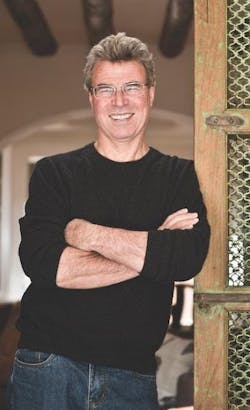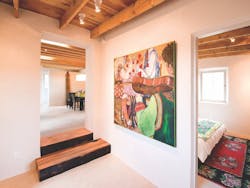Backstory: Riding a Wave to Being a Builder
Steve Thomas’ entry into the construction industry mirrors that of many builders. His father bought and renovated houses and was a real weekend warrior, Thomas says. This was during the early 1960s, and young Thomas accompanied his father on jobs and hung around the docks in San Francisco with him to scavenge mahogany from empty crates left by the stevedores. “He had moxie, and that’s how I got started,” Thomas adds.
But that’s where the traditional arc of a son following in his father’s footsteps ends and Thomas’ multifaceted story begins. First there was surfing. Thomas was in his early teens when he began using power tools to shape his own surfboards. “I saved up money to buy a WEN power planer and would get my mom to drive me down to Greg Noll’s surfboard [shop],” he says. “Then I’d sling fiberglass in the garage.” Thomas’ love of the water had a powerful hold on him that would continue to lead him along as sailor and navigator while he simultaneously charted a career course as historical home renovator, TV show host, and spokesman.
Thomas studied philosophy and medieval aesthetics at Evergreen College, in Olympia, Wash., and started his own house painting business. While his major may not be an obvious choice for someone who likes to work with his hands, it fits this cerebral man whose building philosophy focuses on critical thinking and integrity. “Philosophy is the art of critical thinking,” Thomas says. “When it comes to building, that means you can think critically about every aspect of the build. For the builder who wants to be an excellent builder, the key word is the integrity of the building. It starts from the roots of the building and extends through the trunk to the branches and leaves. It’s part of what makes you feel good in a building.”
That dedication to integrity finds its way into the details of the historical renovations and new builds on which Thomas works. He believes a good builder fights for “what’s right in the building,” which may lead to doing some things simply because it’s the right thing to do, he says, even if clients may not have asked for it. In one recent example—an elaborate wraparound screened porch that had to integrate with an 1830s building on the water in Maine—the renovation seemed simple at first, but as the crew dug down, “they discovered fill and junk from a portion of the building that had been torn down before,” Thomas says. To do it right, Thomas, who works on a time and material basis, would be way over estimate. “But I had to build it right,” he adds. “I was going to pay for it myself if I had to.” Ultimately, the client understood the importance of Thomas’ approach and paid for the work.
Steve Thomas Builders’ total remodel of this 1905 shingle-style Victorian in Port Clyde, Maine, involved modernizing systems and giving the home an energy upgrade while keeping the original exterior features (Photo: Steve Thomas).
Builder Business 101 warns builders against doing things like that if they want to be profitable. But Thomas says it all depends on one’s business model. “I like the satisfaction of putting the toolbelt on,” he says. Much of his work is on an island off the coast of Maine where you see eagles soaring overhead and osprey families teaching their offspring to fly. “I’d rather make less money, just do one project at a time, and not be stuck in the office. You have to be resolved in your own mind and spirit that this is what you want to do, and it has an inherent payback. If you want to get big, you can do really well, but you probably won’t be in the field, you’ll be in the office with your hand on the throttle of the checkbook.”
After graduating from college in 1974, Thomas set sail—literally—for Hawaii and back, then to the Mediterranean to be a first mate on a 103-foot schooner. He went to England with a friend and bought a wooden boat and restored it. They sailed down Europe’s west coast to Madeira and the Canary Islands, across to the Caribbean, and through the Panama Canal to the Galapagos Islands. It was about a year and a half before he got to San Francisco. Along the way, Thomas met Evy Blum, who would later become his wife. “She was on vacation and we were going to have fun for a few weeks,” he says, “and here we are 40-something years later.”
Steve Thomas’ historical renovation efforts aren’t limited to East Coast homes; his interest extends to all types of architecture, such as this adobe bungalow project in a Santa Fe, N.M., historical district (Photo: Doug Merriam).
Together they bought a house in Salem, Mass., and renovated it with the idea that they would sell it to buy a boat to complete the trip around the world. But then, Thomas says, “it was the early ’80s and prime [rates] shot up and real estate stopped.” He became interested in Micronesian navigation and decided to go to Satawal Island, Micronesia, to study traditional navigation “using stars, waves, and birds.” He admits it was a crazy idea, but he did a year of research and learned the language. In 1983 he got a grant for anthropological research and did a field work season. Then he wrote a book called The Last Navigator (published in 1987 and still in print) about the experience.
While in Italy, a chance meeting with a British documentary filmmaker in a restaurant in Venice led to a film for PBS about that experience. That, in turn, led Thomas to WGBH in Boston, which was a stepping stone to his next chapter, in 1989, as host of This Old House. He knew the show didn’t need another builder or architect; it needed someone who could weave together a story. “I learned about design,” Thomas says, “by having to walk into a building on This Old House and say something intelligent about what [viewers were] looking at. As a host, you have to direct the camera to see things in a structure you wouldn’t normally see and explain why the room is so cool or why the façade resonates or how this building takes its place in the historical context of all the other buildings in the neighborhood. It’s really training the eye and the sensibilities.”
Photo: Doug Merriam
Five years later, Thomas moved on to stints at The History Channel with a series called Save Our History, with Discovery’s Planet Green Renovation Nation, and as a spokesman for Habitat for Humanity. All along, he continued to buy and renovate homes, mainly in Santa Fe, N.M., where he and Blum were living. (Years earlier, Blum had become Thomas’ agent and is now COO of Steve Thomas Builders.)
They also had a summer home in Port Clyde, Maine, where, after Thomas left Habitat, he hung out a shingle and focused solely on building. Projects average from $250,000 to $2 million each and he usually does one big job at a time. “The one I’m working on now will take two years because of logistics,” he says. Working on an island in the Northeast means you can work April to Thanksgiving and then, Thomas says, “the weather goes against you and you go skiing.” Materials have to be shipped by barge and it costs 50% more to build anything, he adds.
Not only is the location challenging, but it’s also difficult to find labor. Teens today aren’t playing with power tools in their parents’ garages. “Your capacity as a builder is totally reliant on your labor base,” Thomas points out. He has several people he works with often and trusts, and he believes in paying them well and holding onto them.
Despite the challenges, Thomas says he loves “interesting, offbeat, logistically difficult projects. At the end of the day, I’ve gotten past fancy boats. I enjoy showing up on the jobsite at 7 a.m. and saying, ‘Let’s make it happen!’ I’m 68 and I keep saying I’m only going to do one more and then I do another after that. It’s really fun.”
Stacey Freed covers design and the built world from her home in New York state.




